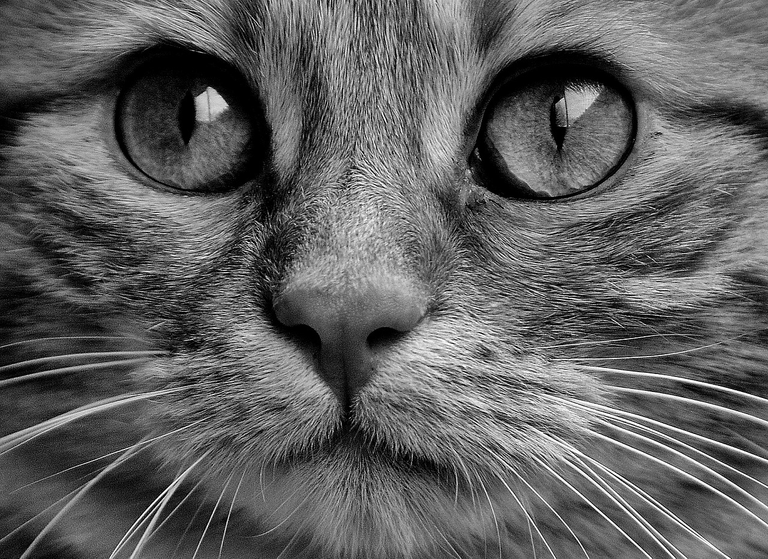The Hounsfield scale and the way of looking at life
The Hounsfield scale (/ˈhaʊnzfiːld/ HOWNZ-feeld), named after Sir Godfrey Hounsfield, is a quantitative scale for describing radiodensity. It is frequently used in CT scans, where its value is also termed CT number.
Definition
The Hounsfield unit (HU) scale is a linear transformation of the original linear attenuation coefficient measurement into one in which the radiodensity of distilled water at standard pressure and temperature (STP) is defined as 0 Hounsfield units (HU), while the radiodensity of air at STP is defined as −1000 HU.Definition copied from: https://en.wikipedia.org/wiki/Hounsfield_scale

https://pixabay.com/photos/cat-black-and-white-cute-mackerel-2495495/
Anyone who knows me outside of Hive, and some of the people I've met on this platform, knows that I work with images. I'm not a photographer, unfortunately... But I am a veterinarian who works with X-rays and CT scans. I haven't yet mastered the technique of Magnetic Resonance Imaging... That's something I have to learn to understand and then be able to establish and put into practice. But I do carry out some conventional (digital) X-rays and CT scans on a daily basis.
The images that I analyze in an appropriate program for the files they are in (DICOM) allow us, with various tools, to make a better distinction between structures, based on their characteristics and the way they interact with x-radiation.
That got me thinking about some of the things we have in life...
The other day I was thinking about the choices we have to make in life, and every day we are tested, classified, grouped into:
1- I am totally in favor (or completely white)
2- I'm totally against it (or completely black)
And in life, nothing is really like that. We can't even establish the instant from which we can say that we are alive, or the immediate instant in which we cease to be.
Why, then, has this absurdly BINARY and unnatural system been and continues to be applied, implemented and taken to extremes at the cost of our quality, or even the adequacy of our true response? Nobody really knows.
We always look for something in common or something that distinguishes us in others. There is always a humanly intrinsic tendency in our biology to do this. We always try to see what we have in common with something we're looking for, or that is pleasing to us, or quite the opposite, we try to establish the greatest distance, the greatest borders, the greatest divisions with what we find repugnant, lesser, of lesser value, or dispersible.
What if we opted for a system in which there were thousands of shades between 0 and 1? Wouldn't we be much more tolerant and much happier? I'm not talking about opening up thousands of classifications for anything and everything, but rather looking at the differences and seeing that there is indeed a gradation between the two points, but that this gradation is not simply “all or nothing”.
For example, if I'm someone who has a very specific political idea, I'd look at whoever was on my left and right, with someone with different ideas to mine, but not necessarily antagonistic.
There may indeed be topics that are extremely fracturing, and that it is not possible to be in a “warm” state, and we can only choose between ‘cold’ and “hot”... But perhaps these situations, contrary to what we might think, are not a majority, but a minority.
We look for someone who isn't a "1", who can't be anything other than a "0". Life doesn't guarantee that. And the Hounsfield Units scale, which I use every day, demonstrates this. Between water, which is zero, and air, which is -1000, there is an infinitude of ashes that make up an organism, an image, a structure. Only something very well defined is an exact value for its entire volume. But can't what isn't also have a value that is slightly closer to the other?
If something has a slightly "darker" or "lighter" part, it is in a state that is not unique, but has characteristics of both materials. Just like life. We're not just one thing, nor do we think just one thing, rejecting everything else that we consider not to be the same...
But life shows that this is not the case!
I hope you enjoyed this slightly crazy connection between one of the most important scales in my professional life and the way I see life.
Cheers🍀
Free image from Pixabay.com
Bibliographic source used in this publication: https://en.wikipedia.org/wiki/Hounsfield_scale


I think the ordinary mind "likes" to categorize things as an easier way to make sense of them. It's actually a lazy way to operate when compared with the current and multifaceted world we live in but I guess old habits die hard, it's the default way people function in on average. I personally do like to observe this variations between two extremes, it gives a fuller picture to how reality works, I think.